What is a fluoroscein angiography?
The fluoroscein is taken just like the fundus photo but this time dye is injected into your bloodstream. A series of pictures are taken to detect blood leakages in your retina.
The fluoroscein is taken just like the fundus photo but this time dye is injected into your bloodstream. A series of pictures are taken to detect blood leakages in your retina.
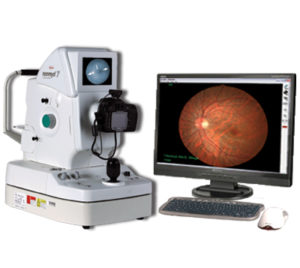 The fundus photo takes a photograph of the retina in the back of your eye. Your eye is dilated and the technician just snaps a picture while you are looking fixatedly at a certain point. A bright flash is used so the camera can get a complete view of the back of your eye. This produces a beautiful colored photograph of all the blood vessels and your optic nerve.
The fundus photo takes a photograph of the retina in the back of your eye. Your eye is dilated and the technician just snaps a picture while you are looking fixatedly at a certain point. A bright flash is used so the camera can get a complete view of the back of your eye. This produces a beautiful colored photograph of all the blood vessels and your optic nerve.
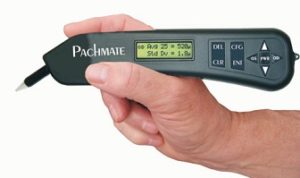 A corneal pachymeter is a device used to measure the thickness of the cornea in a painless and non-evasive way. A technician places the pachymeter onto the surface of your eye and takes an ultrasound picture. This is done usually prior to having cataract surgery.
A corneal pachymeter is a device used to measure the thickness of the cornea in a painless and non-evasive way. A technician places the pachymeter onto the surface of your eye and takes an ultrasound picture. This is done usually prior to having cataract surgery.
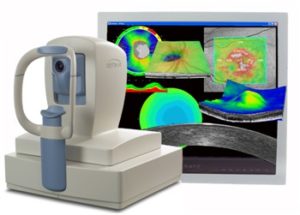 The Ocular Coherence Tomography takes a computerized image of your optic nerve. It is used for diagnostic measures for glaucoma. This test measures the RFNL thickness as well as optic nerve cupping and disc area. As glaucoma progresses, there will be additional thinning of the nerve fiber layer so the OCT is a vital tool in following patients in glaucoma. Careful evaluation of the optic nerve may reveal hemorrhage which indicates a more progressive change that will result in nerve fiber atrophy.
The Ocular Coherence Tomography takes a computerized image of your optic nerve. It is used for diagnostic measures for glaucoma. This test measures the RFNL thickness as well as optic nerve cupping and disc area. As glaucoma progresses, there will be additional thinning of the nerve fiber layer so the OCT is a vital tool in following patients in glaucoma. Careful evaluation of the optic nerve may reveal hemorrhage which indicates a more progressive change that will result in nerve fiber atrophy.
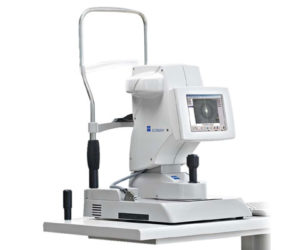 The ophthalmic biometry is done in patients interested in cataract surgery to measure the depth of the anterior chamber in addition to the axial length of the eye. This information is then fed into a program to calculate the correct intraocular lens (IOL) power of the new lens the doctor will implant in your eye. You just focus on a small fixation point and the measurement is achieved with an instrument using light sources at certain wavelengths.
The ophthalmic biometry is done in patients interested in cataract surgery to measure the depth of the anterior chamber in addition to the axial length of the eye. This information is then fed into a program to calculate the correct intraocular lens (IOL) power of the new lens the doctor will implant in your eye. You just focus on a small fixation point and the measurement is achieved with an instrument using light sources at certain wavelengths.
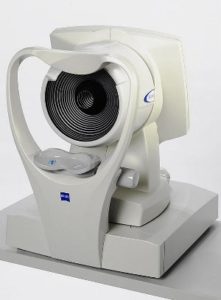 A corneal topography maps a 3D image of the surface of your cornea. You are placed facing a bowl shape that lights up. A camera at the base of the bowl takes pictures of the light pattern reflecting from your cornea. These pictures are analyzed by the computer and a report is produced mapping your cornea.
A corneal topography maps a 3D image of the surface of your cornea. You are placed facing a bowl shape that lights up. A camera at the base of the bowl takes pictures of the light pattern reflecting from your cornea. These pictures are analyzed by the computer and a report is produced mapping your cornea.
This test is used to assist in planning cataract surgery and also for the fitting of contact lenses.
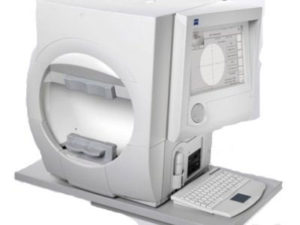 There are two types of Visual Fields tests we do here at BEP. The first one is to measure the extent of the field of vision as the eye fixates straight ahead and second one is to check for Plaquenil toxicity caused by long-term use.
There are two types of Visual Fields tests we do here at BEP. The first one is to measure the extent of the field of vision as the eye fixates straight ahead and second one is to check for Plaquenil toxicity caused by long-term use.
While looking straight ahead into the hemispherical bowl, you click a button every time you see a light flash in your peripheral vision. The machine will then print out a diagram of your field of vision.
This test is often done in our office for patients interested in upper eyelid surgery, both with the eye lids taped up and without, to simulate the difference in visual field pre and post-surgery.
There are thousands of insurance plans out there and it is impossible for us to know what coverage you have based on the limited information that is available on your insurance card. It is ultimately the patient’s responsibility to know what their coverage is, the same as it is a credit card holder’s responsibility to know what interest they are paying. It is a contract you have signed with your insurance agreeing to pay your deductibles, co-pays and co-insurances.
Generally, you pay insurances so they will pay for your medical visit. To keep costs down for the member, an insurance will apply deductibles, co-pays, and/or co-insurances. They end up paying less for your visits at a lower cost to you. A lot of insurance plans will offer lower co-insurances and co-payments the more you go to the doctor throughout the year. Your benefits reset every year, but the month it resets is dependent on your plan. Medicare, for example, resets the first of the year. So if you have met your deductible for 2015 and your plan resets January 1, your insurance will start applying the new deductible January 1.
It is possible for your insurance coverage to apply a deductible, co-pay, and a co-insurance all at the same time. This is where insurance gets really confusing.
Example:
500 – 20 copay = 480
480 – 100 deductible = 380
380 x 25% co-insurance = $95.00 – patient’s share
380 x 75% = $285.00 – insurance’s payment
You end up paying $215.00 and your insurance pays $285.00.
However, on your next visit, you will not have to pay your deductible because it has already been satisfied in your first visit. You will only be responsible for your co-payment and co-insurance.
A deductible is a set monetary number your insurance requires you to pay before they start paying your benefits. This is reapplied every year.
Example:
A co-payment is a set monetary number your insurance requires you to pay every visit. These numbers can change according to what type of visit you have. A primary care physicians’ co-pay may differ from a specialist office (like an ophthalmologist). Your co-pays for surgery and emergency rooms are often different. Many insurances list the different co-pays on the front of their insurance cards.
Example:
A co-insurance is similar to a co-pay, but it is a percentage instead of a set number.
Example:
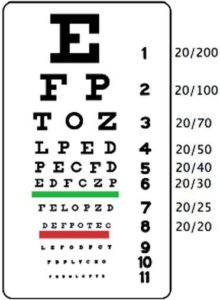 A refraction is the part of the eye exam where the doctor has you look through the phoroptor at the Snellen Eye Chart (the chart with all the letters and the big E at the top)
A refraction is the part of the eye exam where the doctor has you look through the phoroptor at the Snellen Eye Chart (the chart with all the letters and the big E at the top)
This is how the doctor determines your refractive state or more plainly, how he checks your vision. This is also how he gets your glasses prescription. Some insurances cover this charge along with the examination. Some insurances, including Medicare, do not cover this portion and it falls on the responsibility of the patient.
Medicare requires that the refraction is billed separately from the eye examination listing it on their list of non-covered services: Routine eyeglasses, eye examinations, and refractions for prescribing, fitting, or changing eye glasses. Exceptions: post cataract surgery. Refer to benefits under DME prosthetic category.
A health record is created any time you see a health professional such as a doctor, nurse, dentist, chiropractor, or psychiatrist. You could find the following in your health record:
Yes. The Amended HIPAA Privacy Rule states only that you must receive a Privacy Notice telling you how your personal health information will be used and disclosed. Section 164.520(c) (2) (i) (A).
Privacy Notices are often mistaken for consent forms, but they are simply notices telling you what will happen to your medical records.